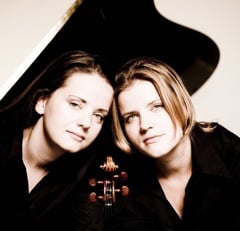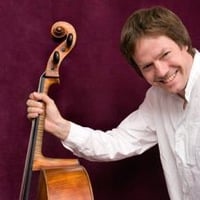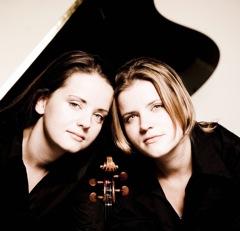It would not be impossible to construct a program of three piano trios more taxing than the one the Skride/Vogler Trio played last Tuesday at Herbst Theatre. It might, though, be difficult to find anyone willing to play it. Where Beethoven’s “Ghost” Trio is the light appetizer, Shostakovich’s Op. 67 Trio the main course, and Brahms’ B-Major Trio (Op. 8) dessert, the one thing you can be certain of is that you are in the presence of three ravenous chamber players.

Photo by Marco Borrgreve
Baiba and Lauma Skride, violinist and pianist respectively, are older and younger sisters, and have been in town before as duo-recitalists. Cellist Jan Vogler has, so far as I know, not played here before. Their San Francisco Performances–sponsored recital was an object lesson in chamber playing. You don’t have to think alike; you just have to understand your colleagues.
String players are generally pragmatists when it comes to bow allotment; you use as much bow as you have to, to get the effect you want. For all that, there are philosophical camps. At one extreme you find players who treat every inch of bow as a precious resource, to be tapped as sparingly as possible. Hilary Hahn, for example, is one of those. At the other extreme are players who figure that as long as God saw fit to provide them with a couple of feet of horsehair per bowstroke, there’s no point in not using all of it.
Baiba Skride is, shall we say, the anti–Hilary Hahn.

The remarkable thing is that on Wednesday she managed to use so much bow, without ever sounding as though she was skating over the strings. Hers is an airy sound, but not an insubstantial one; and despite the piano lid being full up, her sister never overbalanced her.
That, it’s true, owed as much to Lauma Skride’s discretion as to Baiba’s strength. The younger Skride showed a positive genius for soft playing. There was no lack of power — in places like the many full-voiced passages in the Brahms, or the opening of the Shostakovich’s Largo third movement, she achieved an arresting depth of tone. Her capacity to play lightly and perfectly evenly at once, though, was the marvel. So light a touch almost always means an occasional note that doesn’t speak, or speaks imperfectly. Lauma Skride, however, pulled off every risk. And there were many risks.
These two seemed, at first, strangely matched with Jan Vogler. On the Hahn-to-Skride bowstroke continuum, Vogler is nearer the Hahn end. His sound is brighter, denser, more penetrating than hers. (Is it mere coincidence that in the first movements of all three pieces on the program, the first lyrical idea you hear is a cello solo?)
Intonation on a Knife’s Edge
And yet the blend between the two was better than that account suggests. The biggest disagreement, to my ears, was oddly not about timbre, but intonation. This program was pocked with octave-heavy minefields for the violin and cello. There’s the “Ghost” Trio’s famously nasty slow movement; there are the almost-identical ends of the Brahms’ second and third movements; and there’s any amount of stuff in the Shostakovich (the composer favored bare octaves more than did any other major figure that I can think of). A disconcerting fraction of these passages were just not quite solid, and more than once one player or the other audibly adjusted after placing the note.
The places you’d have expected blend issues, by contrast, were almost without exception magnificent. The opening of the first movement of the Shostakovich involves the cello in harmonics joined in close harmony by the violin in “normal” notes. I’ve never heard the two lines sound so akin as they were between Skride and Vogler: ethereal, eerie, and icy (and, incidentally, balanced to perfection). In the slow movement of the Brahms, the violin and cello repeatedly start on the same note and then move apart from one another; there the illusion of one line’s suddenly becoming two was flawlessly done.
And there was a strong, compelling sense of common intention behind all three performances. This is a recently established ensemble, one with some kinks yet to be worked out, yet it seems to me leagues ahead of the ordinary “let’s us three celebrities get together and do a tour” sort of short-term trio. I don’t know whether such busy soloists will be inclined to stick with the project, but I hope they do.

